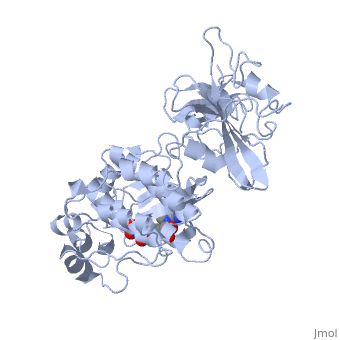SRC
From Proteopedia
The c-src proto-oncogene encodes a protein tyrosine kinase. The v-src oncogene of the Rous sarcoma virus encodes a mutated, activated form of this enzyme. In particular, the virally encoded V-SRC protein lacks the carboxyl-terminus of the normal C-SRC protein. Phosphopeptide mapping and site-directed mutagenesis revealed the importance of two tyrosine (TYR) residues that are critical for the activity and regulation of C-SRC, TYR416 and TYR527. Insertional mutagenesis and comparisons with other proteins revealed the presence of three highly conserved SRC Homology domains, SH1, SH2, and SH3. SH1 comprises the catalytic protein kinase. Within SH1 is TYR416 which hinders access to the active site. Phosphorylation of TYR416 induces a conformational change that is required for full kinase activity (see below). In contrast, when TYR527, which lies carboxy-terminal to the SH1 domain is phosphorylated, the kinase is inactive. SH2 domains were shown to bind to peptides containing phosphotyrosine. In particular, the SH2 domain of C-SRC binds to phospho-TYR527. Although this binding is reversible, the bound state predominates. This bound state prevents the kinase from phosphorylating substrates. Therefore, phosphorylation of TYR527 greatly diminishes autophosphorylation of TYR416. In this regard, the phosphorylation of TYR527 by another protein kinase (CSK) results in the inactivation of C-SRC. Conversely, removal of TYR527 by truncation (as in V-SRC) or by substitution with PHE (by site-directed mutagenesis) causes constitutive activation of the kinase. Similarly, the physiological dephosphorylation of TYR527 results in an opening of the protein structure by release of the SH2 domain. The loop which contains TYR416 and occludes the active site of the SH1 kinase domain is first autophosphorylated. phospho-TYR416 then alters the conformation of this loop, resulting in a dramatic increase in protein kinase activity. SH3 domains were shown to bind to peptides with multiple adjacent proline residues. The SH3 domain of C-SRC binds to the SH2 domain of C-SRC, thereby helping to stabilize the conformation of the entire protein. The SH2 domain of C-SRC can bind to phospho-TYR on other proteins (e.g. an activated receptor tyrosine kinase like PDGF-R), thereby opening the C-SRC protein conformation, exposing phospho-TYR527 to protein phosphatases, and resulting in activation of C-SRC. In some cases interactions of the SH3 domain with other proteins can also facilitate this activation process.
INACTIVE C-SRC from PDB 2src ACTIVATED C-SRC from PDB 1y57 Notes: The INACTIVE C-SRC structure was solved with a non-hydrolyzable ATP analog [Xu W, et al. Molec Cell 3: 629-38 (1999)]. The ACTIVED C-SRC structure was solved with an inhibitor that alters the conformation of the kinase activation loop even in the absence of phosphorylation of TYR416 [Cowan-Jacob SW, et al. Structure 13: 861-71 (2005)]. These INACTIVE and ACTIVATED C-SRC structures are displayed in similar orientations relative to the kinase (SH1) domain to facilitate your understanding of the mechanism of activation. However, an additional amino-terminal domain (SH4) not shown in either structure tethers the protein to the inner plasma membrane via hydrophobic fatty acid chains (myristate and palmitate) that are covalently bound near the amino terminus of C-SRC. This membrane tethering likely provides a fixed attachment point which the remainder of the protein rolls up towards or opens away from during activation. Review Articles: Martin GS. The hunting of the Src. Nat Rev Mol Cell Biol 2:467-75 (2001). Harrison SC. Variations on a Src-like theme. Cell 112:737-40 (2003). Regulatory Domains and Residues: |
| ||||||||||
3D structures of Proto-oncogene tyrosine-protein kinase SRC
Additional Resources
For additional information, see: Cancer
For additional information, see: Oncogenes
Proteopedia Page Contributors and Editors (what is this?)
Michal Harel, Alexander Berchansky, David Canner, Eran Hodis, Joseph Lipsick

